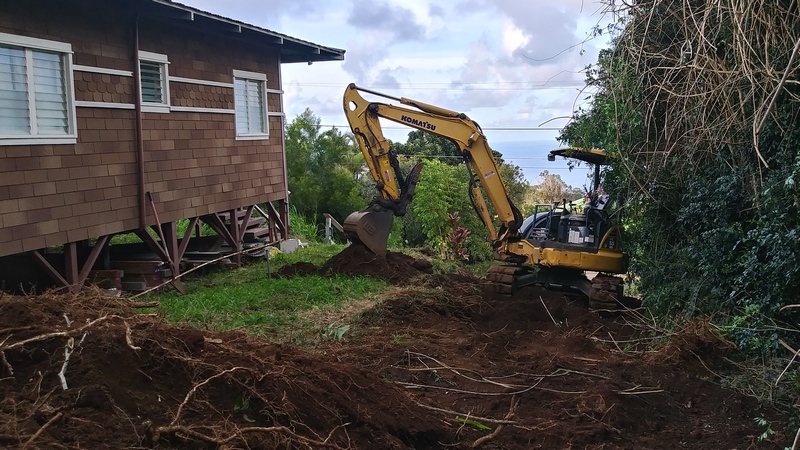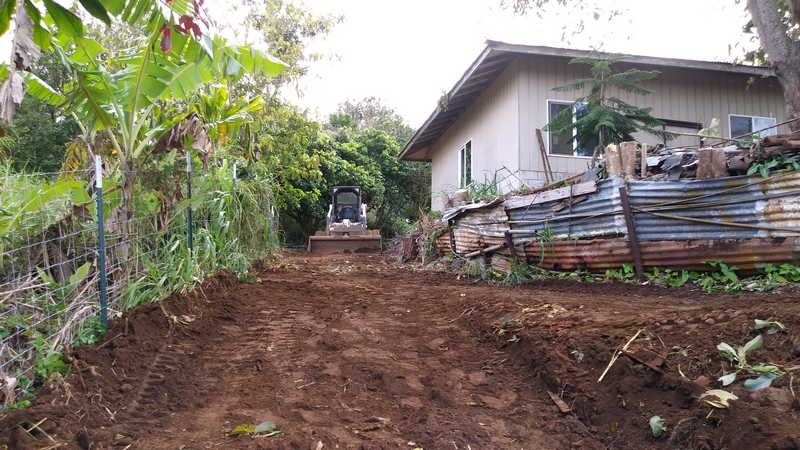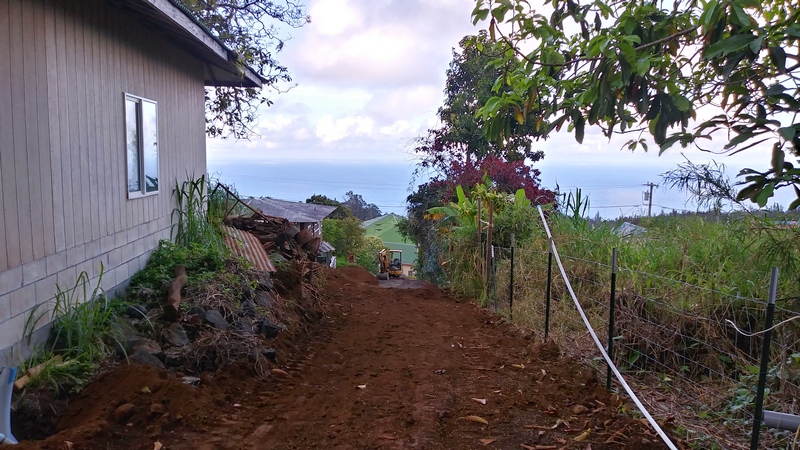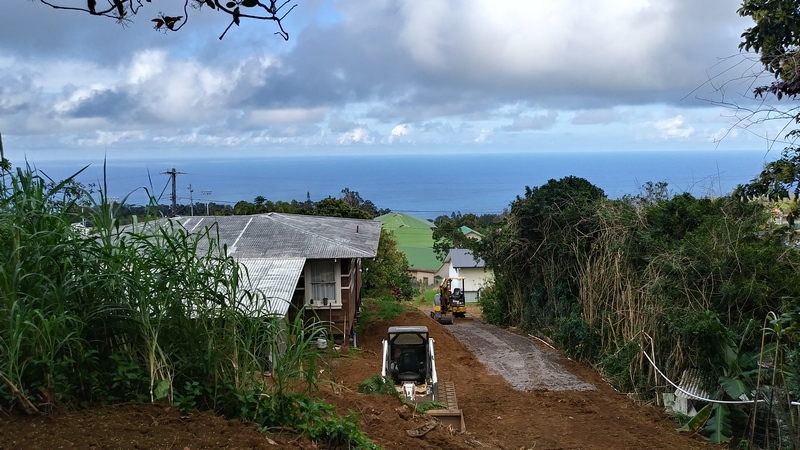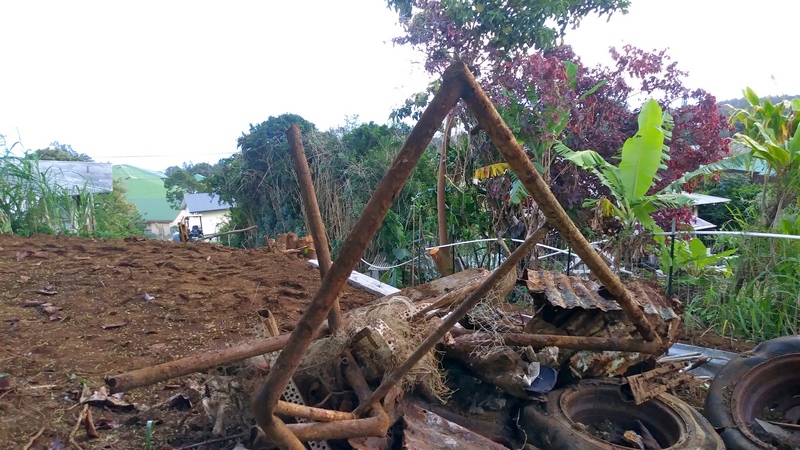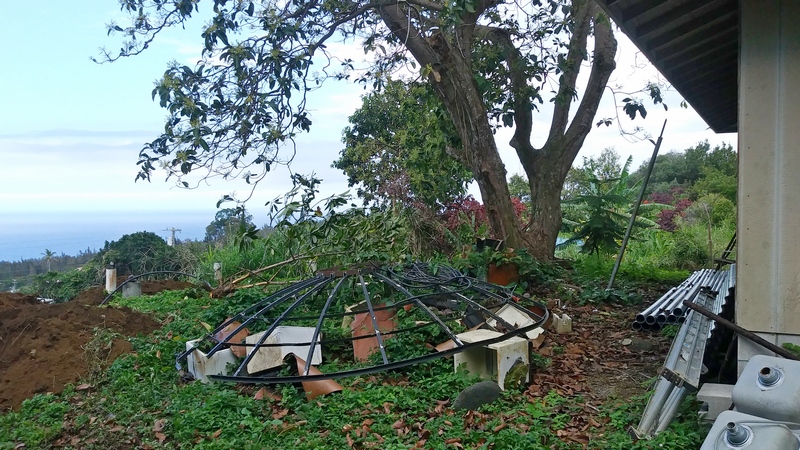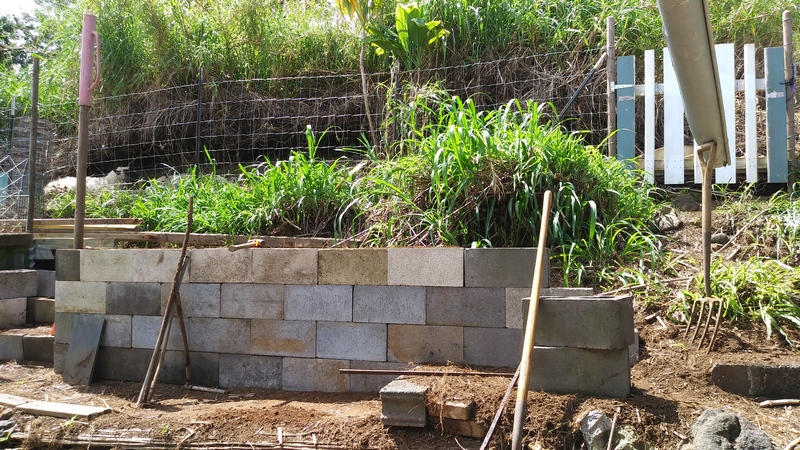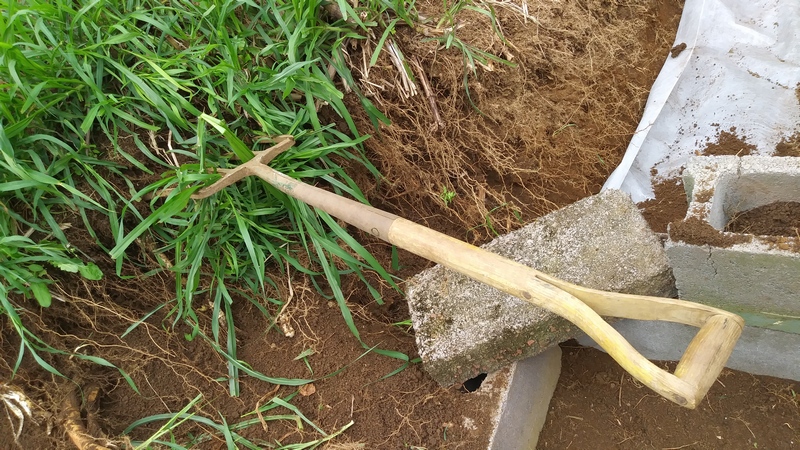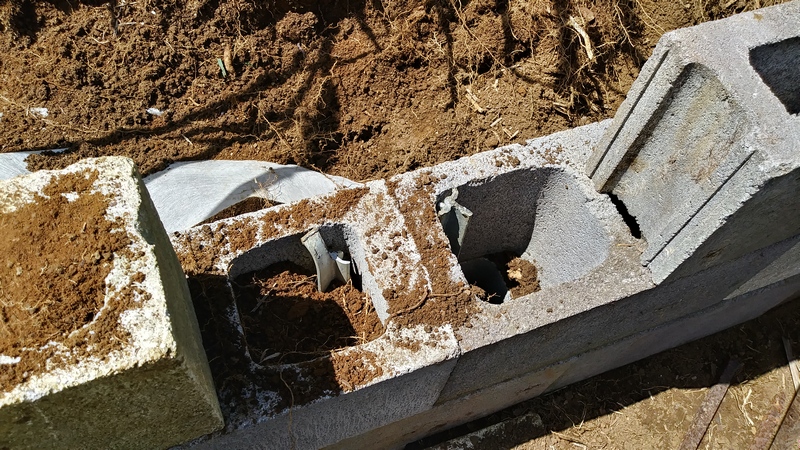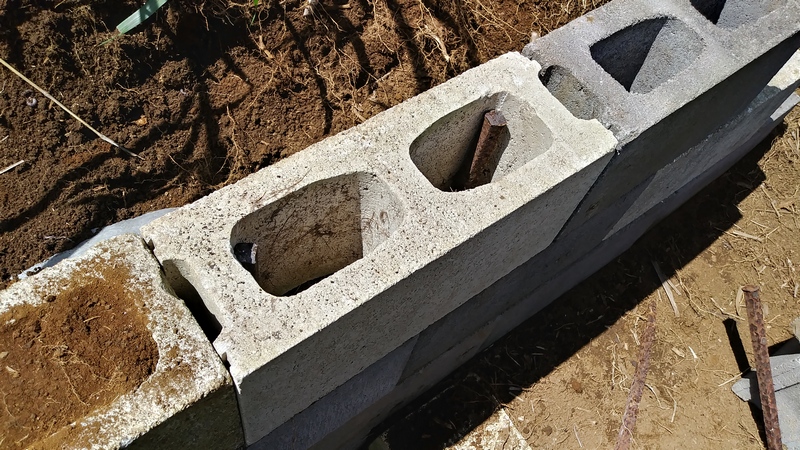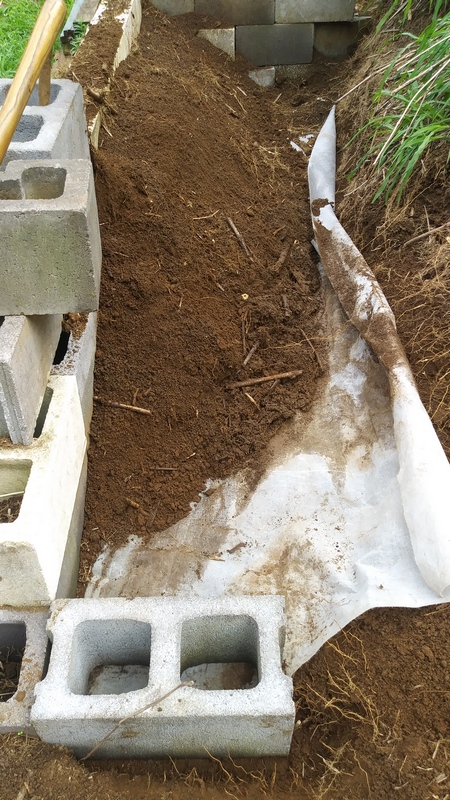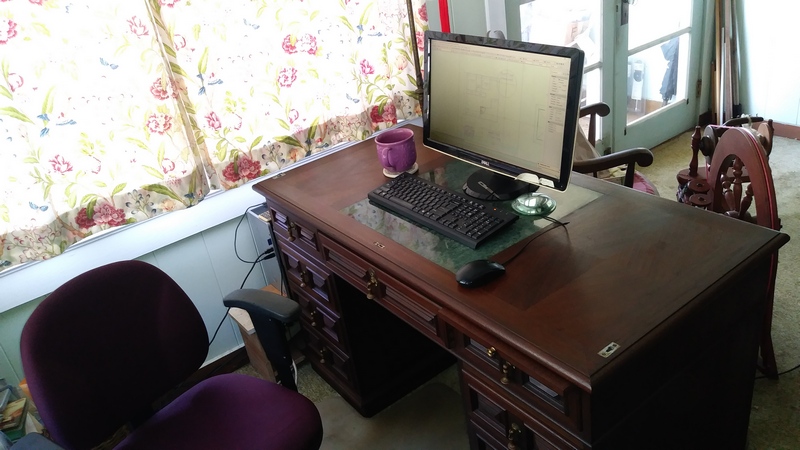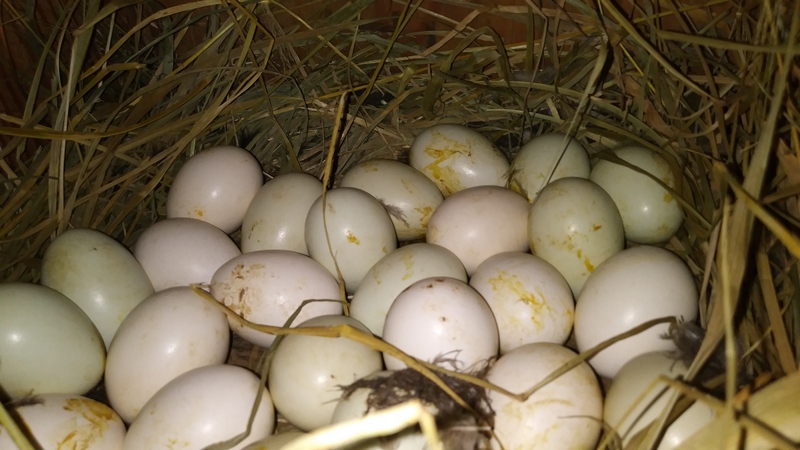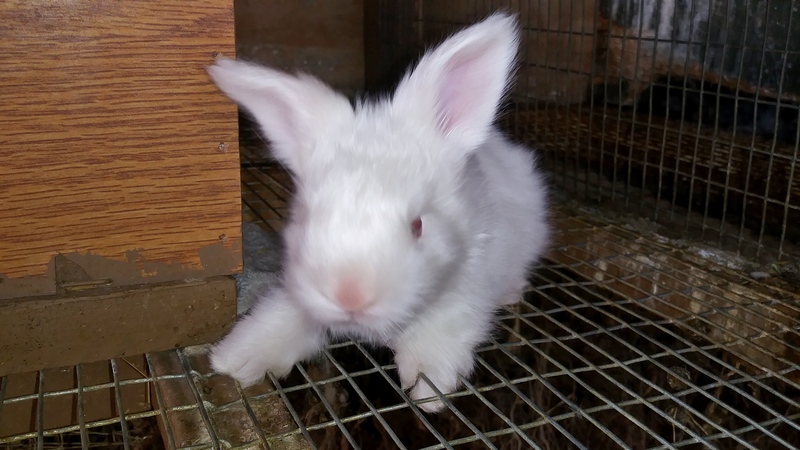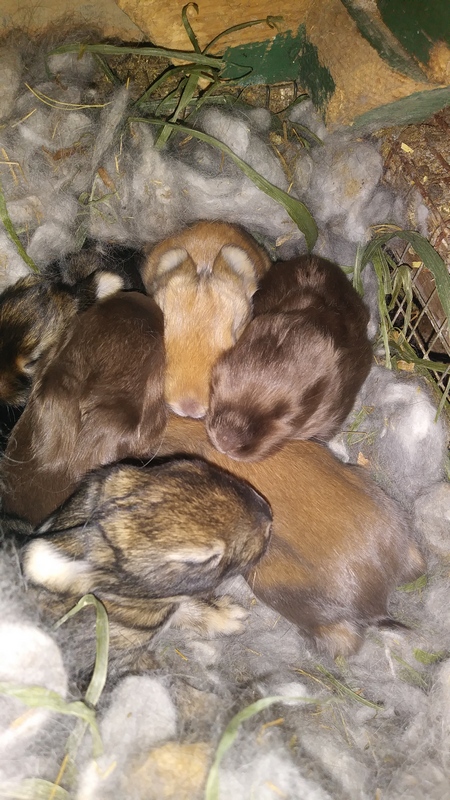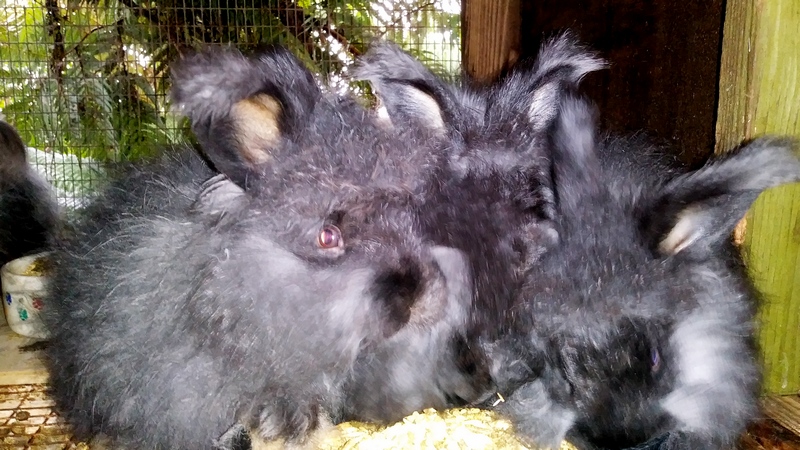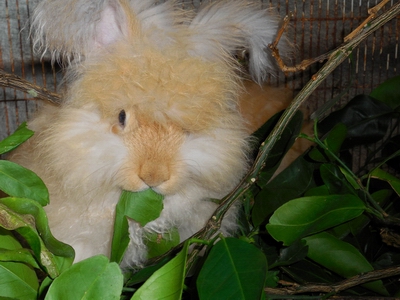March 21st, 2021
Rain, Rain & Yet More Rain
you'd think it was rainy season or something
The sheep are turning green! I mean, rain is supposed to make things green, but should that include sheep? One of the things on the project list is to build them their little sheep shed, although it keeps raining so we've not been out there working on it.
There's the beginnings of their sheep shed in the corner of the picture; one of the roof trusses. So far, one truss has been dragged up into the sheep pasture and we kinda know where it will be built. That's about as far as that project has gotten at the moment. The plan was to build the garden - which was only supposed to take a couple of days - and then be building the sheep shed while the excavator was working on the driveway of the Little Rental. Then work on the carport area of the Little Rental. But, it's been raining and so all the planning is totally tossed out the window.
It's been raining for the past several days and the bucket of the bobcat is all full of water. They'd just gotten some of the gravel spread on the driveway and then it started raining and it's pretty much been at it ever since. Sigh! They put something called 'one inch minus' on the driveway and I'd thought it was going to wash away, but had it been able to have been spread out and then drove over a bit, all this rain would have solidified it. But, that didn't happen so now we have a few gullies and such for the equipment to fuss over when they come back.
The Excavator Arrived!
the Little Rental will finally get a driveway!
There has been several truckloads of rock put in the old carport area behind the excavator and he's now starting on the initial grading of the yard area between the Little Rental and the big mock orange hedge. Lots of roots from the hedge, it would probably be a good thing to prune that a lot to make up for the loss of it's root system. It needed pruning anyway, this just puts that higher on the 'to do' list.
Mark is pretty amazing with that machine. He was working closely around houses, fences, hedges and all sorts of obstacles and never hitting anything other than what he wanted to. I found it a bit spooky for his machine to be sitting on top of the slope, but he didn't seem to be phased at all.
This is just the 'initial grading' although it looks ready to have gravel spread on it. There will be underground utilities so it will be dug up for the utility trenches. (arrgh!) The tin metal on the right side of the picture is a retaining wall for the Avocado Plateau. We didn't install it and aren't quite sure what it gonna happen with it. It'd be nice to replace it with a rock wall, but that ain't a cheap option. I think for now, and maybe for a lot longer than that, it will stay a metal wall. Maybe I can get some vines to grow over the edge or some narrow vertical hedge to grow up it? Paint it green? Ignore it? At some point something will probably be done with it, but we haven't a clue quite what yet.
There's the stumps of about six medium sized avocado trees which had been growing along the edges of the tin wall. They'd fallen from the big avo tree, rolled down to the edge of the plateau, got stuck by the tin and then sprouted. Not sure if they did anything to help hold the wall or if they were getting ready to push it over? In any case, it was way too many avo trees so they were removed. That Norfolk pine in the picture is gone now, too. Norfolks get absolutely ginormous and it was way too close to the building. Eventually, the Avocado Plateau will have the big avo and a tea pavilion over by the front edge of it. At least, that's the plan now, we will see what actually happens.
Of course, as soon as it's graded, it has to all be dug up again! Although, I suppose, it's pretty hard to know how deep to dig for the utilities unless there's an initial grading done first. Still, it seemed like about four steps backwards instead of four steps forwards in the construction process. It will be nice to have underground utilities so there won't be wires in the view.
During the digging of the trenches, all kinds of buried rubbish was dug up. Since the truck had already taken away the rubbish that had been under the grasses (as well as the grasses) the new found rubbish was stacked on the side of the plateau. Once the driveway is finished, we can go up with the trailer to haul it away.
We've been waiting for awhile for the excavator to show up. What happens is Mark gets hired to do one job and then he lets the next folks on his job list know when the first job is expected to finish so we will know when to expect him. However, having an excavator on site just opens the doors to all kinds of other little jobs to be done other than the one that started the whole thing. So, he was kept busy with other projects at the other jobsite for a bit longer than he expected. But, we're not in a huge rush and it's really exciting to finally have construction started on the driveway up to the back of the Little Rental and the Workshop.
Mark is really good with his excavator, almost to the point of being delicate, if one can use such a term when referring to an excavator. Excavators are generally really messy with loads of clean up afterwards, and although there still is some cleanup, there's much less after Mark is done working with his excavator than any other I've seen. He's also good at noticing trees and other desirable vegetation and doesn't just squish everything in sight.
The project started with several tuckloads of rock brought in to fill in where the old carport had been. Then several truckloads of green waste was hauled off after there was a day of grubbing up the Guinea grass and other vegetation in the way. Several extra avocado trees were taken down as well as the remains of the Royal palm that had been taken down earlier so there was a lot of green waste.
Then the basic grading was done and we were really pleased when the new driveway isn't as steep as we'd expected. Mark is really good with that excavator. Of course, after getting the basic grading done, then the whole thing had to be dug up so utility piping could be installed. A pipe for electric, cable and water were all installed and then the driveway was regraded. Finally some gravel was brought in and they were spreading that around when the rains started and it's pretty much been raining since then. (Sigh!) Which means it's not done yet so we can't drive up to the Workshop quite yet. Still, at some point soon, we hope!
There's a surprising amount of rubbish that was grubbed up during the driveway grading. Some sort of rusty old pipe gate, old tires, old bits of rusty metal, huge chunks of carpet, just all kinds of 'stuff'. They hauled out a dozen or two of those small refrigerators, but there had been over forty of them to start with and there's still at least a half dozen left. All broken and rusty, although I'm sure they weren't that nasty when they were brought in. Mark and his helper took away truckloads of green waste as well as a load of general rubbish that was dug up, but there's still a bit more that was dug up after they'd taken the truckload away. Once the driveway is done - and if this rain ever stops - then we will be able to go up there with the trailer and haul off the remainder.
There's still a bunch of those dead tiny refrigerators up there still to be hauled off. The last pile of them is under the old satellite dish that I hope to make into a roof for a pavilion. This area in the picture is what I'm calling the 'Avocado Plateau' these days. Mostly since it's a flat spot about five feet above the driveway below and there's the monster avo tree so 'Avocado Plateau' seems a natural name for it. A lot of the other smaller avocado trees that were sprouting up around the big avo were removed during the driveway construction so the big avo will be in solitary splendor. Hopefully the new soil on it's roots and less rubbish around will be good for it although there's still a lot of clearing up of rubbish to be done on the plateau.
I'm hoping to build a tea pavilion over on the edge. There's some old foundation posts of some sort over there on the left side of the picture. That seems like a great spot for a pavilion. You can't really tell from the picture, but just past that short fat white post, the plateau drops off about five feet. The excavator put some piles of soil around the edges of the plateau so I'll be able to rake them smooth and level out the plateau a bit. Much nicer than digging up soil and hauling it up hill with a shovel and a bucket. Just past the piles of fresh soil and about five feet down, there's the 'middle driveway'. That will let us circle the Workshop. Those old foundation posts on the edge of the plateau will be an awesome spot for a pavilion but the Pavilion Project is way down on the "to do" list, if I get it started this year, I'll be surprised.
In other projects - it always seems like there's several going on at once - the newest raised bed garden is still under construction. Rain has slowed that project way down, too. Along with a pulled muscle several weeks ago, although that has gotten better it still reminds me occasionally that one should not shift too many bricks in one day.
Starting with Construction Step One around here, the first thing is to remove the Guinea grass.
My newest weapon of choice against Guinea grass is a potato fork. It's kinda like a pitch fork except on steroids. The tines are much sturdier and square instead of round. Shorter handle, too, I think although I dunno if we have an actual pitch fork around here to compare it to. The potato fork is really good at getting the chunky roots of the guinea grass out of the soil. Kinda as if they were potatoes. Guinea grass has a big chunky under ground root with alot of little narrow rootlets going out from it for quite aways. The potato fork digs up the big chunky root and the little rootlets can be cut off or pulled up along with the fat part. Not that it's easy, but it's easier than a shovel.
After the Guinea grass is removed, the lower three layers of the concrete blocks are staked together with some chopped off bits of fencing. We found them at the transfer station one day and figured they'd be useful for something sometime. Much better to reuse than to recycle when possible, IMHO. The cut off bits of fence are about three to four feet long and perfect for this. The top layer of concrete blocks are thinner than the bottom layers so they're spiked together with concrete stakes. Then the holes are filled with soil and I'll plant marigolds or bunching onions in the holes.
Hopefully all this staking with metal pins will keep the blocks from pulling apart. I don't really want to make a permanant wall so stakes and soil filled will have to be enough to keep it together. It's worked for a few years for the first concrete block gardens that were built here, although this newest one is taller than the original ones. We will see how it goes, I guess.
A couple of those blocks on the top of the wall aren't where they're supposed to be, they're just stacked on the wall to get them out of the way for the moment. The end block isn't set in place yet, eiher. It's just there so can see how much deeper it needs to be to be level with the other blocks.
Behind the wall of concrete blocks, there's a layer of weed mat. Then the soil is filled in. As the bank behind gets cut back further, another section of weed mat will be installed and then as the bank is cut back, the soil will fill in the garden. It is taking a lot longer than I expected, but a lot of the delay can be attributed to the weather.
Our stalwart fencing crew spent some grueling hours whacking paths through the Guinea grass in this area back behind the WorkShop. After several hours, we had a few paths. Then Mark and his Machine showed up. It still took Mark and his excavator about a half day, BUT, he cleared the whole thing! Woot!
Before the evil Guinea grass has a chance to take over again, the fence across the back property line is being put in. Even though it is still kinda raining. There's one fence post left to put in, it seems a good idea to put a wooden fence post in the center since wooden ones don't bend. Not that there will be cows leaning on them, but just for the principal of the thing. So, one more fence post, then stretch fence. This project may actually only take a few days, we will see as it goes along.
Some sort of hedge or vines growing on the fence may be good for a bit of visual block. I thought about dwarf mulberry, but dunno where to get them from. Raspberries and blackberries usually have thorns on them? There as coffee along there, although coffee is kinda spindly to make a decent hedge. Maybe I'll just grow some beans on the fence while figureing out what should be good for a hedge? Passion fruits grow as a vine and grow quickly, but we don't really eat that many passion fruits, so I dunno if we need a whole fence full of them. Well, beans will work and they only last a few months before they need to be replanted. Unless they're lima beans then they will last for several years, but then we'd have several years worth of lima beans and that may not be such a good thing, either.
For projects that have been finished, the new desk is now set up and functional. I'm typing to you on it as we speak, speaking (or rather typing) figuratively of course.
The little silver square fitting near edge of the desktop is where the roll top would be attached. Since the roll top doesn't work well with computer monitors, it's over on top of the sideboard in the kitchen. It kinda looks a little odd there, although it is useful for filing mail and sorting odd things into the drawers. Not sure if it's going to stay there or not, but couldn't think of anywhere else useful to put it.
I'm really liking the larger desk, there's more room for papers on the top of it and more drawers for filing things. There's still some more stuff that can be put in it since there's all the stuff behind my chair (which you notice is not in the picture since it's messy) that can be sorted through and put in the drawers. Mostly old computer disks, papers and such, but it's a whole stack of them and almost constitutes an entirely new project to sort and file them. Although, if these rains continue, well, that would be an inside project, wouldn't it?
Black Hen (yeah, I know, not a very imaginative name) has started to set and I think the other hens were still going in there and adding more eggs to the nest. She's got more than two dozen eggs to sit on and I doubt she's gonna be able to hatch out very many of them. Guess we will see. She is in one of the bunny nest boxes, so maybe she will be able to keep most of them warm enough to hatch?
Since she's started setting, Ricky Rooster seems to have vanished. Not sure what happened to him, but he's not been around for the past several days. This morning, the neighbor's dog was out chasing the two white hens who flew up into the trees. Ricky wasn't a very good flier, so perhaps that's what happened to him? Maybe he just got chased away and decided he liked where ever he ended up better? Well, Ricky was a rooster, so there's kinda a love-hate, well, a love-annoyance relationship with roosters. If there were just a non-crowing rooster, I'd get one. In any case, the eggs that Black Hen is sitting on may be the last batch of fertile eggs until a new rooster shows up. Not that we really need more chickens. Three hens is enough if we can keep the mongoose from eating all the eggs.
Mongoose had attacked both of Veronica and Aster's babies. The little black one lost toes on several of it's feet and the little white one lost some toes, too. That was when they were just a week old and didn't even have their eyes open yet. The mongoose was chased away, the little ones brought inside and they were bandaged up and antibiotic was put on so they'd not get infections. I wasn't sure how they were going to do, but they did amazingly well. They were healed within a week, bunnies have a really fast metabolism and baby bunnies probably even more so. We deployed the mongoose traps so bunnies wouldn't be injured again and Flower is inspecting the catch. She doesn't want to get any closer than that since mongoose can be very fierce. With really sharp pointy teeth. Hopefully baby bunnies and any baby chicks that hatch will now be safe.
This is the little white bunny that was injured. She/he is all better now and quite friendly for such a traumatic start in life. I wasn't certain how much of a 'special needs' bunny they were going to be, but they've completely recovered and don't seem bothered by having less toes much at all.
Lotus & Vinnie's babies are older and showing their colors now. Since this picture was taken, they've opened their eyes, although it's been so wet and rainy that they have mostly been staying in their nest and not out for pictures.
There are seven in the litter. Two agouti (wild rabbit color), two chocolate, one black, one fawn and one tortoiseshell of some sort. One of the agouti and maybe the fawn will stay here, the rest will probably go to new homes when they're old enough. But, it's still really early to tell.
Rose & DaffyDill's babies are getting to the really fluffy and cute stage. One of them has gone to a Waldorf school to help kids learn how to make yarn. One more will be flying to Maui next week. There's still three more who will go to new homes although we don't know which ones yet.
Click on the picture above for the previous blog entry
or check the list of older blog posts at the bottom of this page
Click on the bunny for the Home Page


